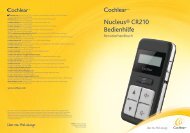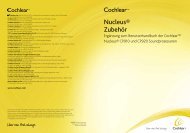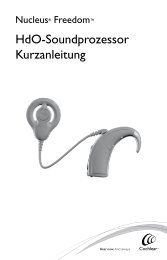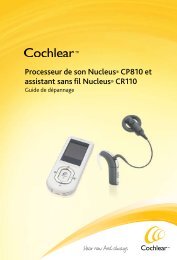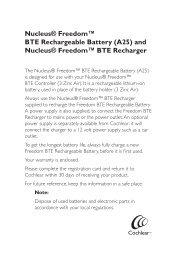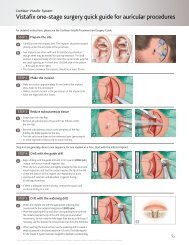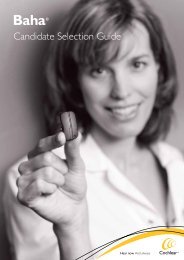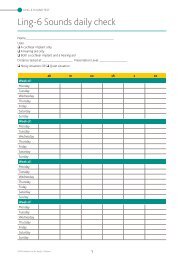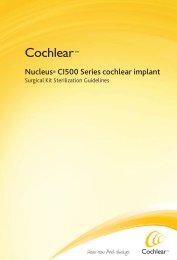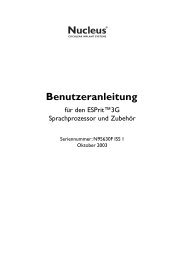User Manual - Cochlear
User Manual - Cochlear
User Manual - Cochlear
Create successful ePaper yourself
Turn your PDF publications into a flip-book with our unique Google optimized e-Paper software.
Warnings and precautions<br />
General advice<br />
A sound processor will not restore normal<br />
hearing and will not prevent or improve a hearing<br />
impairment resulting from organic conditions.<br />
• Infrequent use of a sound processor may not<br />
permit a user to attain full benefit from it.<br />
• The use of a sound processor is only part of hearing<br />
rehabilitation and may need to be supplemented<br />
by auditory training and instructions in lip-reading.<br />
Warnings<br />
• The sound processor is a digital, electrical, medical<br />
instrument designed for specific<br />
use. As such, due care and attention must<br />
be exercised by the user at all times.<br />
• The sound processor is not waterproof!<br />
Never wear it in heavy rain, in the bath or shower!<br />
• Do not expose the sound processor to extreme<br />
-20 °C<br />
(-4 °F)<br />
+50 °C<br />
(+122 °F)<br />
temperatures. The sound processor is designed to<br />
operate within the temperature ranges +5°C<br />
(+41°F) to +40°C (+104°F).<br />
In particular, battery performance deteriorates in<br />
temperatures under +5°C. The processor should<br />
not be subject, at any time, to temperatures below<br />
-20°C (-4°F) or above +50°C (+122°F).<br />
• This product is not suitable for use in flammable<br />
and/or explosive environments.<br />
• If you are to undergo an MRI (Magnetic Resonance<br />
Imaging), remove the sound processor prior to the<br />
procedure. The implant and abutment remain in<br />
place.<br />
• Always use the audio adapter when connecting an<br />
external audio source to your sound processor.<br />
• Portable and mobile RF (radio frequency)<br />
communications equipment can affect the<br />
performance of your sound processor.<br />
• The sound processor is suitable for use in<br />
electromagnetic environments with mains power of<br />
typical commercial or hospital quality, and power<br />
frequency magnetic fields of typical commercial or<br />
hospital levels.<br />
It is intended for use in an electromagnetic<br />
environment in which radiated RF (radio frequency)<br />
disturbances are controlled.<br />
• Interference may occur in the vicinity of equipment<br />
with the symbol to the right.<br />
• Dispose of batteries and electronic items in<br />
accordance with your local regulations.<br />
• Do not dispose of your sound processor in<br />
an incinerator or into fire.<br />
If the sound processor becomes soaked with<br />
water:<br />
1. Immediately open the battery door, lift the battery<br />
hatch and remove the battery.<br />
2. Put the sound processor in a container with drying<br />
capsules such as a Dri-aid kit or similar. Leave the<br />
processor to dry out overnight. Drying kits are<br />
available from most hearing care professionals.<br />
26 27<br />
English



